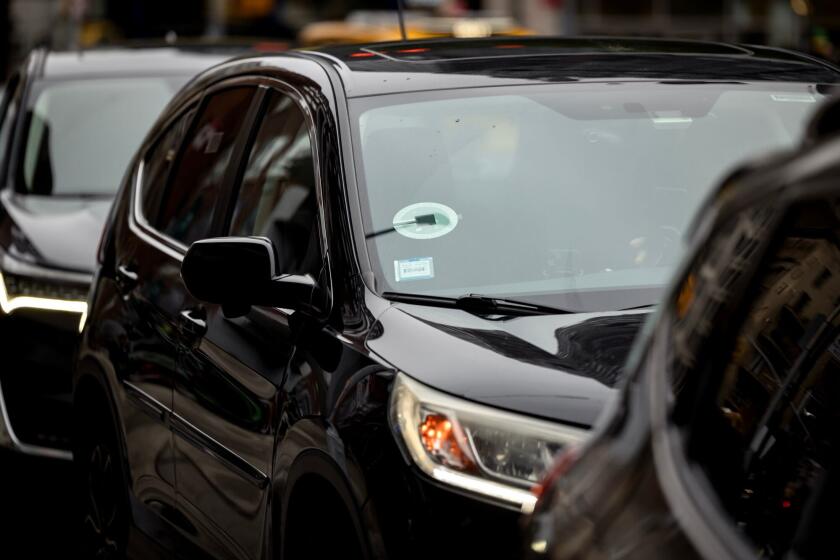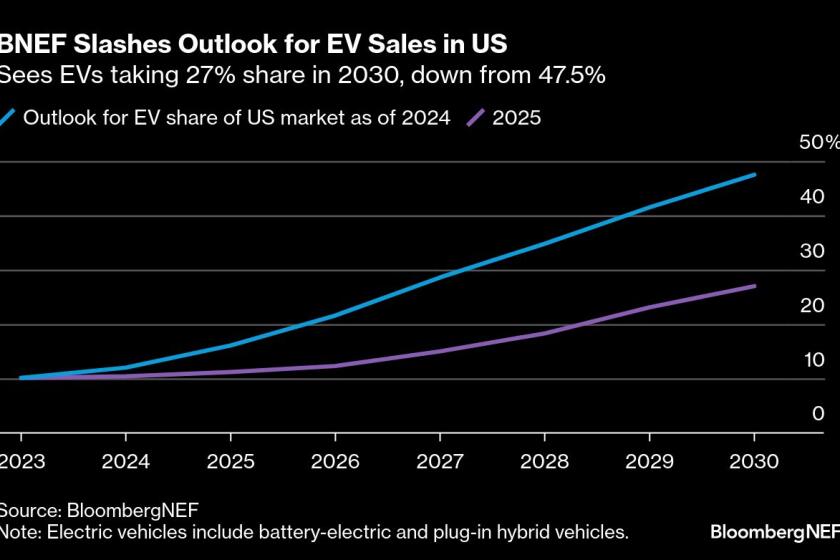Opulence is standard for German trio
- Share via
A new Big Three is gearing up to capture the hearts and dollars of well-heeled American car buyers.
Instead of General Motors, Ford and Chrysler, the battle is among German manufacturers -- Volkswagen, Mercedes-Benz and BMW -- who are taking over the ultra-luxury market.
Volkswagen bought Rolls-Royce and Bentley in 1998, but BMW scored a coup by acquiring rights to the Rolls-Royce name. BMW allowed VW to use the Rolls-Royce name for five years.
This year, BMW took control of Rolls-Royce, and the two tony British marques become rivals after 71 years of being in the same family.
Mercedes-Benz joins the club this year with the Maybach, a brand that starts at $300,000, more than double anything in Mercedes’ lineup. Sales tax alone on a Maybach will exceed the price of the least-expensive Mercedes, the $24,950 C230 coupe.
All three brands introduced their models this month at the Los Angeles and Detroit auto shows, and will aggressively pursue buyers.
The number of prospective customers seems tiny, given that Rolls and Bentley combined to sell 750 cars in the U.S. last year in a market of more than 17 million vehicles. All three say there is room to grow in a class that attracts buyers with an average net worth of $14 million, a clientele whose fortunes don’t typically rise and fall with the stock market.
Buyers range from repeat customers with old money to entrepreneurs and chief executives rewarding themselves, and athletes and entertainers splurging on expensive cars as fashion statements.
Independent auto analyst Maryann Keller questions whether there are enough buyers to support all three brands under current economic conditions. “The world isn’t creating billionaires like it was a few years ago,” she said. “It’s bad timing because the economic climate throughout the world isn’t very good, and this just isn’t the appropriate time for conspicuous consumption.”
Buyers who can afford upper-crust brands such as Rolls and Bentley may opt instead for an expensive sports car: a Ferrari, Lamborghini or Aston Martin. “Aston Martin has a James Bond 007 image -- a sexy sports car that Sean Connery used to drive,” Keller said. “What do Rolls and Bentley have?”
Bentley recognizes that it has a stodgy image and is trying to create a new identity as the performance leader of the group.
“We have a challenge to make clear what Bentley stands for, especially in the U.S., because for many years we have sat under the shadow of Rolls,” said Alasdair Stewart, chief executive of Bentley Motors Inc.
Early in its history, Bentley’s reputation was for high-powered touring and race cars. After Rolls-Royce bought Bentley in 1931, the two came to share engines and cars, and Bentley became the slightly downscale half of the pair, largely selling hand-me-downs from Rolls.
As Bentley prepared to go on its own, it displayed more spunk. In recent years, it has promoted performance-oriented turbocharged models and rekindled its racing heritage by entering the 24 Hours of Le Mans endurance race.
The first model designed and built under Volkswagen’s ownership will be the Continental GT, a racy coupe with a 12-cylinder VW engine that’s due in the U.S. later this year. Bentley says the Continental GT will be the fastest four-seat coupe in the world, topping out at more than 180 mph.
The Continental GT will start at about $150,000, some $50,000 less than the Arnage R, currently the cheapest Bentley. Stewart said pricing the new car above the top end of Mercedes-Benz (the $125,000 S-Class) but below Rolls will broaden Bentley’s appeal and allow U.S. sales to grow to about 1,200 cars in 2004 and 3,000 to 3,500 by 2007.
“We’re quite confident the business is there,” Stewart said.
Volkswagen has invested nearly $2 billion in Bentley, including the purchase of the company, developing the new model and modernizing the factory in Crewe, England, Stewart said, adding that VW’s ownership will give Bentley the resources it needs to compete as a distinct brand.
Rolls-Royce will start fresh with a new sedan that goes on sale in the spring, leaving the old range of models to Bentley. BMW will ship bodies and engines from Germany to a new plant in Goodwood, England, where final assembly will be done by hand. The plant has capacity to build about 1,000 cars a year.
Vernon Smith, a sales executive at Steve Foley Rolls-Royce & Bentley in Northbrook, Ill., said the new Rolls sedan maintains the brand’s traditional formal look.
The Phantom is about 230 inches long, 18 inches longer than the Silver Seraph that it replaces. An upright grille that is larger than the Silver Seraph’s dominates the front end.
“It is immediately recognizable as a Rolls-Royce, and the driver sits very high in it,” Smith said.
“It has great presence on the road. It clearly wants to be the No. 1 car in the world.”
The engine is a V-12 adapted from the 5.4-liter used in the BMW 7-Series sedan, but tuned to produce more torque to match the weight of the new Rolls, about 6,000 pounds.
For high-end versions, Smith said, “I’m sure it will be over $300,000 and probably under $350,000,” the same range as the Maybach.
As the newest member of the club, Maybach (pronounced my-bock) must prove it belongs with the incumbents, much like Lexus had to in 1990 when it went head-to-head with Mercedes and BMW.
Two versions of a Maybach sedan will be sold beginning this summer, the 57 and the 62, the numbers denoting their metric measurements (about 18.7 feet and 20 feet, respectively). Both will have a 453-horsepower turbocharged V-12 engine and conservative styling.
“A lot of people may not recognize what it is, but every potential Maybach buyer will know what it is,” spokesman Fred Heiler said, adding that there will be no mass-market advertising of the brand.
The cars will be sold in the U.S. through about 80 Mercedes-Benz dealers who will ante up $600,000 to $900,000 to acquire a Maybach franchise and set up sales and service areas in their facilities.
With base prices of about $300,000 for the 57 and $350,000 for the 62, dealers won’t keep cars in stock. Instead, cars will be built on order in Stuttgart, Germany, with about half the 1,000-unit annual production earmarked for the U.S.
Building a Maybach will take about four months and a $50,000 deposit to initiate.
“The process is very much like commissioning a yacht. None of the cars will be built to specification, only to someone’s order,” Heiler said.






